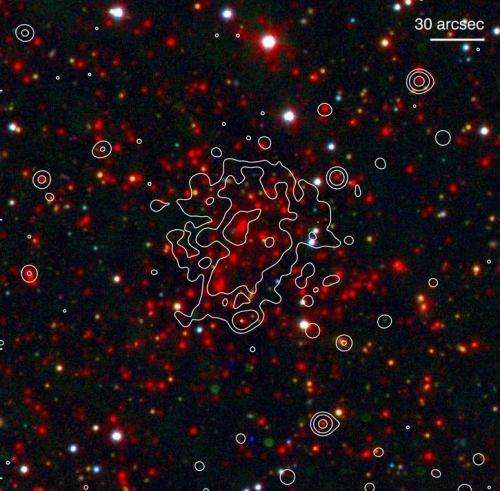The most massive distant object known

(PhysOrg.com) -- Galaxies often occur in groups. Our own Milky Way galaxy, for example, and its local neighborhood with about fifty galaxies are at the edge of the Virgo Cluster, a collection of somewhere between 1200 and 2000 galaxies. Galaxy clusters are the most massive objects in the universe, and their formation is thought to have begun from small spatial variations in the density of matter in the early universe. Clusters are therefore powerful probes of the growth of structure in the early universe, and their numbers and masses help astronomers test cosmological models including galaxy formation.
CfA astronomers Ryan Foley, Matt Ashby, Mark Brodwin, Giovanni Fazio, Bill Forman, Christine Jones, Steve Murray, Brian Stalder, Tony Stark, and Chris Stubbs, along with a large team of colleagues, have just published the discovery paper of the most massive distant cluster known, SPT-CLJ2106-5844, weighing in at 1.3 thousand trillion solar masses (more than about a thousand times the Milky Way's mass). This makes it the most massive object currently known in the distant universe. (A few larger ones exist nearby, but they have had billions of years longer to accumulate matter.)
Their detection relied on the property that most of the normal matter in clusters (that is, not considering dark matter) appears not to be in the galaxies themselves, but rather in the vast, intergalactic spaces between galaxies in a cluster. This intergalactic gas is very hot and its atoms are ionized, the result of the matter accreting into the cluster. The hot gas emits X-rays, and also distorts the millimeter radiation as it interacts with the light of the cosmic microwave background.
The scientists used the South Pole Telescope to survey about 3% of the whole sky at millimeter wavelengths, searching for the characteristic brightness dips produced by these clusters. This particular, massive cluster was relatively easily spotted in the millimeter survey data. X-ray images from the Chandra X-ray Observatory were then used to determine the character of the hot gas, and X-ray spectra measured the cluster's distance from its velocity. Sensitive optical and infrared velocity observations were also obtained to confirm the its redshift distance: it is so far away that its light has been traveling for over 7.5 billion years. One of the most interesting results of this discovery is that, if current models of how the universe evolved are accurate, clusters of this size are very rare in the young universe. In fact, this cluster could even be unique.
Provided by Harvard-Smithsonian Center for Astrophysics


















